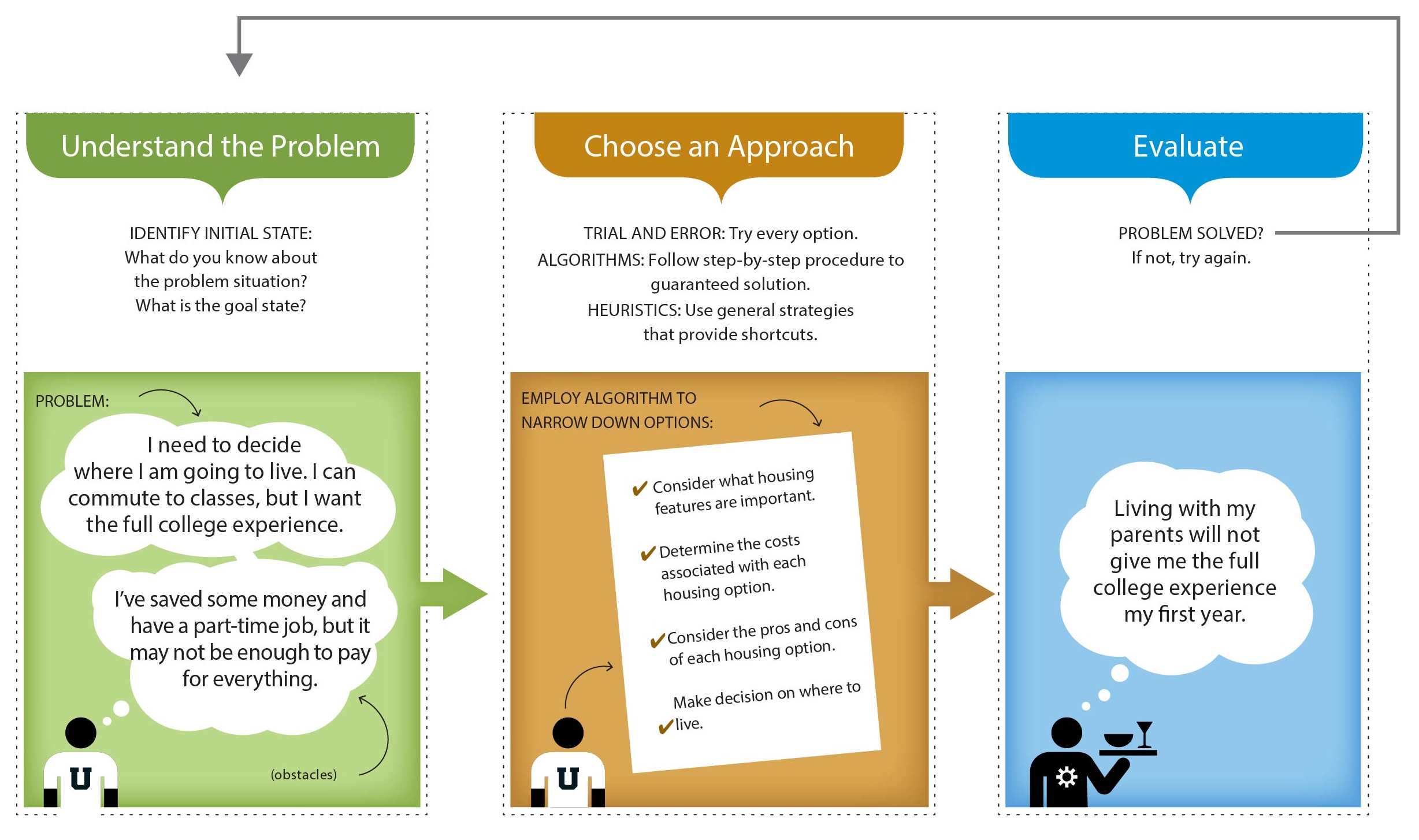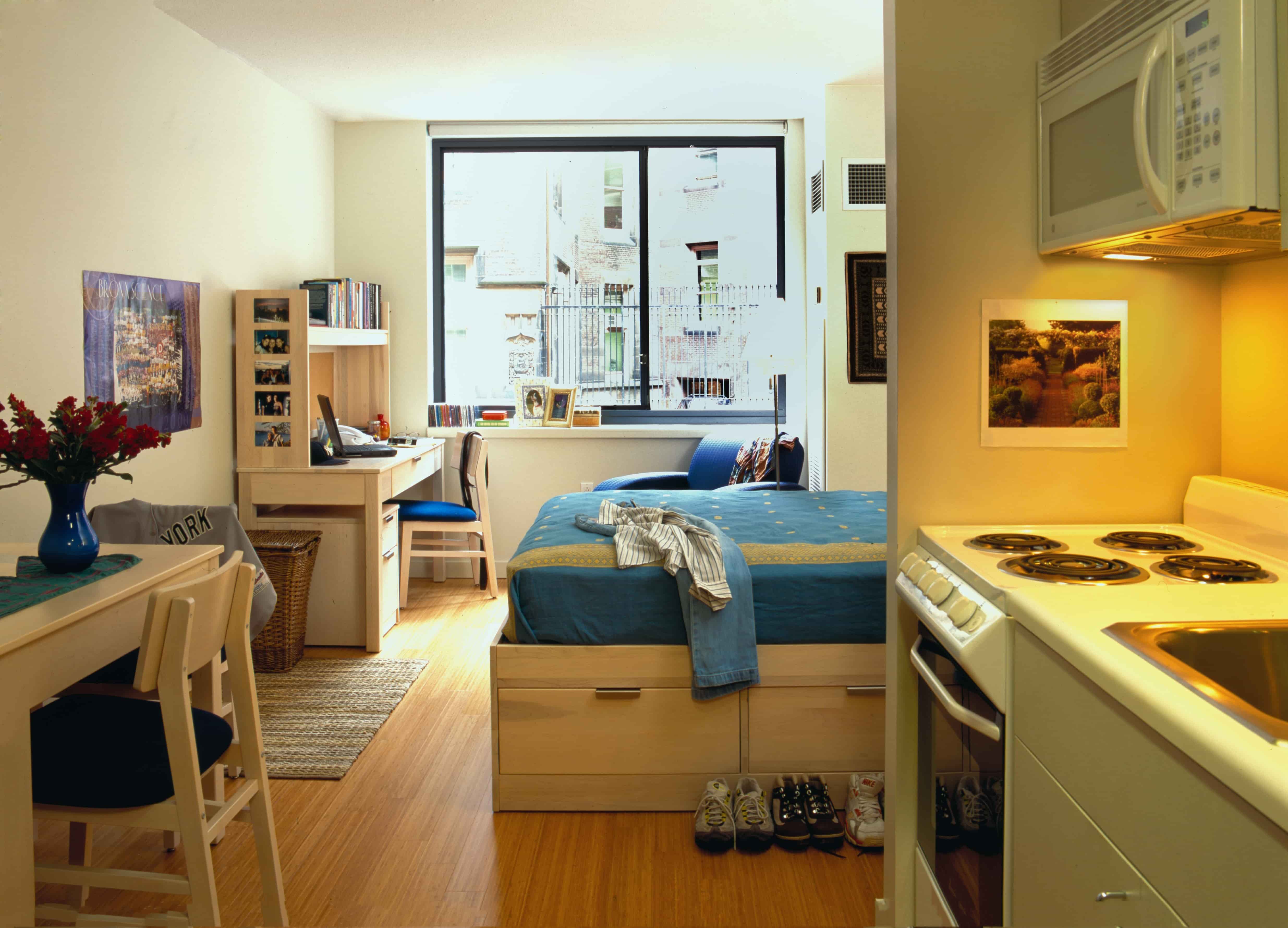Chapter 7. Cognition, Language, and Intellige
7.1

You have just been accepted into your first choice of college. Congratulations! You applied for numerous scholarships and recently found out that you received partial funding. The funding will cover 90% of tuition, but you still need to cover the balance, purchase your own textbooks, and pay your own living expenses. You work part-time for $10 an hour, but have some money saved up that will help to cover expenses.
Now you need to decide where you are going to live! The college is less than an hour from your parents’ home, so you could live at home and commute. But, you want the full college experience and want to live in a dorm on campus. You would also consider living in an apartment off campus. How do you decide?
7.2
Problem solving and decision making are related to one another and occur at the same time. But they are also different from one another. Problem solving involves figuring out how to achieve a goal. Once you understand a problem, you can identify an approach to solving it. There are several approaches to pick from, such as trial and error, the use of algorithms and heuristics, and even insight. A successful approach will help you manage obstacles that come from the problem itself.
How will you tackle your problem and make a decision? Look at the image below to see how problem solving and decision making are related.

Question
Question
7.3
Sometimes the way we think about a problem can be a barrier to solving it. Being stuck in a certain way of thinking about a problem can limit what we see as available approaches. This is evident in mental sets.
For instance, can you connect all of the dots in the square below using only 4 straight lines and without crossing any dot more than once without lifting your finger or the pencil (if using your textbook)? Do you have a mental set that would prevent you from accomplishing this task?

7.4
Your solution should look like this.
Did your mental set cause you to assume the square implied boundaries that would prevent you from extending the line outside of the square itself? If so, it may not have occurred to you that you could draw lines extending outside of the square.

7.5
Functional fixedness is another barrier that can hinder problem solving. It stops you from finding other creative uses for objects that might help solve a problem. Children have less trouble with functional fixedness than adults because they have not become accustomed to using familiar objects in a fixed wayGerman, T. P., & Defeyter, M. A. (2000). Immunity to functional fixedness in young children. Psychonomic Bulletin & Review, 7, 707–712.. Yet, the more children observe others using objects in particular ways, the less likely they are to be innovative. Sometimes observation and pedagogy can get in the way of creativity, leading to “restricted exploration and learning”Carr, K., Kendal, R. L., & Flynn, E. G. (2015). Imitate or innovate? Children’s innovation is influenced by the efficacy of observed behaviour. PCognition, 142, 322–332.. Would functional fixedness prevent you from solving the problem in this video?
ANNOUNCER: There are many methods to determine how humans think, a famous example is known as the Duncker problem. This involves giving a person a task; how to fix a candle to a wall using only matches and a box of thumbtacks. While seemingly strange, this task is specifically designed to force the participant to make some interesting decisions. After many repetitions of this study, it has been discovered that if you give the participant the tacks inside of the box, they generally won't consider the box as part of the materials they can use. And as a result, they are much less likely to reach the correct solution. If given the tacks in a box separately, the correct solution is achieved much more often.
Just another look into how humans perceive the world around them.
7.6

Emotional barriers can also get in the way of problem solving. Negative emotions, such as feeling rushed or anxious, affect your ability to think clearly and creatively. Positive emotions, on the other hand, may set the stage for innovative thinking. Good feelings are thought to promote a “flexible” way of thinking, one that helps you to shift attention quickly and helps to develop new strategies for a changing environment Isen, A. (2008). Some ways in which positive affect influences decision making and problem solving. In M. Lewis, J. M. Haviland-Jones, & L. F. Barrett (Eds.), Handbook of emotions(3rd ed., pp. 548–573). New York, NY: Guilford Press.. Another important factor is cultural orientation. Those from highly individualistic societies, such as the United States, tend to be action oriented in their problem solving, making a lot of decisions in a short amount of time. In contrast, those from more collectivist countries, such as Brazil, tend to be more careful in their approach, making fewer decisions when faced with a problem ( Güss, D. (2011). Fire and ice: Testing a model on culture and complex problem solving. Journal of Cross-Cultural Psychology, 42, 1279–1298.Ohbuchi, K., Fukushima, O., & Tedeschi, J. T. (1999). Cultural values in conflict management: Goal orientation, goal attainment, and tactical decision. . Journal of Cross-Cultural Psychology, 30,51–70.).
7.7
Now that you have learned about barriers to problem solving, let’s answer some questions about it.
Question
Question
Question
qVO3xEN0WoEsFFENWRsTe3wd0SdKhzyFKWlR0b5coxnmQIi3CeDjVOpteSea3N6LR6Nt98my5KIjvxpzzdhT9oHcc0Mb2yDKninozE54k1zTMRdGWBVAwQOzYIE/M4JN+XGD+KZnJxPQF2B6U74Qvjs23K1aqyNs7.8
Problem solving is different from decision making, which involves predicting the future. What will happen if you choose to live in a residence hall on campus? What will happen if you choose to live with your parents? You have almost no way of knowing the outcome.
There are many ways to go about making decisions. One way to make a decision is to focus on a single aspect, or feature, of the situation. Perhaps you are only concerned with the costs of your living arrangement. However, this single-feature approach may not be effective for making complex decisions, in which there are many features to consider, such as finances, campus involvement, academic performance, and others. With a more complex decision, such as deciding where to live, you could use the additive model of decision making, which requires you to create a list of the important features for each option.
Below is a list of features related to your housing options. Rank each item from most to least importance to you, by dragging and dropping each item into a spot on the hierarchy. Move items by dragging them to the correct location or by selecting an item and then selecting the location where it should move.
Question
q6XWQJflWtVkaFwYK6NEneWW7Y2E1zzqMCTXSg==7.9
Question
Now that you have identified the housing features that are important to you, can you identify which housing option (living with parents, on campus, apartment off campus) has which feature?



| Parents home | Residence hall | Off-campus apartment | |
|---|---|---|---|
| Campus involvement | SZMTLfByv/nE7efySG5TpgBuYx4rbqZii8wtLQAljgRk3ZByfdbHZIMx0Y7DNiLm3Jf4SiItlm/w2q640bwPiQLoKTbMQl2AmrmR1w== | gmy9JhqvtXniXf8MwYe1zlURC3eoiSnSwyul6mPOSzTGHvRNQGM8ZQ/I6sSyAxucBR6bplm+NT4sCJH2k/4d2LYsSDdP7EhY2J5eWw== | am7jn60ZPYFWiYrWWOLbx2pSbdRVJ9Iwd05awZDbBeFt5U0FugSmdBS+KIqCZrve2HbM2F89RNRjMNZizQ6XlRSmKFaYG4c360tZLg== |
| Dining hall | A5Fl6VMiuRuzEUI0ggidfBx8RS3z1394xO7nYkBON82Si5lH2p+0yG0x6nJmiqIDZfP4g5S2de1laoRDgGUffC3G/IsLzZEnNuxpIA== | LnJkEx3F8MLLA9cqmvQfGXSHcMvaN+bQaS2X2auD0IZXXm0Vt3+qxaE9flli/hnM0LdJOBt94veBEXb9nSM60WjSgA19rGElhigkZg== | YozCbkIlZnxs3nx7kIr7baNBTWe84hHPBPFtchKpf/zF/DuDPQi2eCq6H2/V/4Hg5wF1nnE59tOs+nhoFA3UiFd1x1gFHHqYbNMRLA== |
| Library | lKLCnN2zqhhyyFLRkxkNmVTBhXQc73KH8AU8cil+kRX9jo4B6bu7HfD4x7/teE8auIpJN2hfxPiN8LUZYOKnFAcK0S1agkZA2sesLg== | cXR+FVs65xt61BFw2biG6tjcUJUjoSeOzghRUTbexp1tc6c10wWYj8j9CD6W60QJslUrC+Wq80uu7rgAPTGoGBNCIWV9ingR0xsTEg== | LcJQiGDtgY1d3IKDIeMTpTut+DMJL+frVd9B6SbcfyNhoUvvMFSTTmLLSZmAAUWeu1I0oPk1seSJ1PhVDOzc94D3EKQOeLidQLk10w== |
| Meal plan | 9RfASHh8PlkEn1saUstAifofx3b4hIO/Qj2pEiAi7GGpBY+YufELOMBuOZQFh6qU18tJxHS+/fq65zSg4oOfXfGbdoI0125BAfORyg== | pHt2vdG50s8d+xmpZE4lX35Nh/XV+LvABL+3NIsqHK9gXW4LqPj0ZGBy9dyOJDN6gEfs4B1LlDwbFi6xU+xFKBpMmLKvnqMN+D1sGg== | x7PHbiT0LFBr/FBKN9NF/G6qH0oiDVQWwD7El+vzgVR/FxmZkrrrzAe+Q5aiqmIEtlIbGFQhoOEG4ZbGWkHuXKZp/dnFRIqM+9Z0pw== |
| Housecleaning services | FyBf1+EzEU3YxrjUb+KcErOT+7U9ul40tlAj6/19jJvmarsa7RltSB5xqJDKd+SllBaECZp384gMUdJqHKM1hHWouR8fbZuhBTiNtQ== | 2FfNK2TMQotAKLa/b4v/ZKO2wa+nbiuus2hUY/4oKaAX3exBlYYtxk62WEoTl/tyi3tMrf5Wr2F1Kqt1q+J6Zcf+pH1jhfSdusDt2A== | qjrSgTHV8pcwazrHFb3HNk+ZzGo1A8Egicv1inQBPIvyDANitNK8FeSwjyWP+81iKEBLwdgOGbH7fjhhEerWbzmdqpIX7aMSDN9f8g== |
| Internet access | S7YFP6sNGnC5Y7YG39f/QKqTP+P574qVxzJjPomdHdx5+y3PBI+baW6GMlryy2ZCeTFy9x3AIg0ZHrhVR+CmBItFMNvU22O95445WA== | 63XeQ0RsJWIMzsvYztqtsKCDtunnDNWmqiTSOIdimkMFUl+NPdACqKDX4JdEOWJqZcelbg1ytSCY8/BWxv7Wvw3i9UZcdRRW4WwtWA== | 9T70S5JO7F4xk5/gSegu0Rm80TnOqAtMQVmpB9pXFybKlfNPDECfljQ6Vsdu44rzbgTOkBmQFpPLAAj6n92kfAkDQ/BINakliDL4WQ== |
| Create friendships | ENOZVO2LsLPFyYTB9RxuoB7/xQ7RVpSKapJrljWh0uKVBhbGrAAN62zwalKXbSu1/a5K2jsFxsjGjKNcgnbsIsAduaT18f54j3UOpw== | 3WruUL2fmQSmoazHVJb+CUKr1qIO/gLjpzKa9li2QCIohw7Az304mx6uxa1evbcFn/oUJtkoHcDQCAc18OjUgYA65OiDQ/+MQJzQ9g== | DyhPrHjlVs2DQ+BduPQPj78F3AiykLi4jW44upKIGIy2oynmZUduoSUE31OSSaTVeYaEBlh6nhqb9/g3lNpcYUuAnPRK6MaZ8VUZog== |
| Privacy | t6Z2Y3PmiBpwbnEMbhE9KQwBOCvcEsvmW59+Nd60xtO41s1ZwEk5YCaItsn0N3NL/ohkCuwnOsAD4gE5fVcS1RYse7blhytmq9ydAQ== | 4qqnXnB2Scnv5dzdeKW8Clq/V098sH566lprizDXV5sykaLz/g9UsSCJwV+KRl87rpkqfPC+BQ/+xnF2J3OZ6BapannCMiu1YYJBFQ== | oaCaKv9JwRqeIwWOODRVZwGgYtEU2KErSgvrZfWcXEJuYvDlaxhqeSDhJUL9kzFtRHsceebmWzjMqFKxECbCaTolEoeflQC9kyiVaA== |
| Quiet | ndTCneFEU/p08FZtGk+P4Qb4R82RQLj5BlGA1ulw6TQY/tOKORIqcSeyTgug4u5fl37jaELdkiUXCb1PW5//+8RCq3fGjL/Kno5CDQ== | i4hSetnTee9YltLUpcYwdFCMP1Hvi5L8sUKNvuJD9BiSexoOA2YjdPKa1Vyp2ar3SKoSHkTx1VHd2ICB3WsGbGGkTNofBXm6ZjZ3sg== | Ti7qTfQ/52xJYAtRDnOZNn6wFEnjScsVecLXEZVEBeCraLHpf92Pz1cG5tCUHHfhuv9t72VbB9Z5FFE60PrDsXDGrWiJLx4qMXaOIg== |
| Study time | KL47lj/PDurEXrW49Tuk9aTQdAmMqKNPD+dLcIxr4rh/SAQMoEzBPYvGBD/zhRr8CQSCrEbRWcO9MEevF08xA9gqcy7zmucti7aVF/eNSic= | sE8swtzyymaNzYcKHnePfq7AD2IdYDU26S8QkYX1M8iUj/SzWyBWbTHZSvnKzvAAqPu8h6HutYTKz1ayuQf6pKvMzrQ7AOsbw2y7pZ30Wkw= | PM02puXQNGz/ra6nItqJAAKR3hH0vjy3SKXjjnBOTHVtJXOJfooNSEyuLJSSeh3pStpA6UXp7laez5Evgc/62Xw/TvQ9SHwVIRyZnD254Yc= |
| Change of scenery | yPi/akYGhB5SZnqAlbik4FVL9lvZMgTGX+xDFtWagMsQ78tTUrr0qa73iNIOn4DHLsQw4UjljofkKi74KtiVZslH+8xGRLnB+rdCdlqVI60= | M0l4sMsyu1wa1R2vViA6yICM6VEmbuzhq2TaIcEgoe3pEW7e1bE2ZPDu0IdcL4rrpRJVVsf3vD6gqXKewP2eQSQmocJjjq82+H89CirKUZ8= | pdk8Qnb4G2wKqFlXqLwY6FleUN0ftM4h9N+OPYniAB1eHNKgNv2DzC84+C4OU3fv4BQbbDaJ/TBaMjzpe3VNvzGlNlu8ChDShBqgu5PZGbo= |
| Independence | xs7BZcUF7mkbfWmstj06AcWSqDPcqLujLxWENj5lbNxJDV+sir5UhOMMoifQZSfCTP6QnfsNV7jsGxWqZL71a5e0GZJF1MM4YQat4tLYEpg= | Bp8IuAM4OSP2K2drgtFwuJa1ocnQBLLy41TKBKKTpz6zdyDgu9ghck4l3a04K3FloFdNHWz5n5asdG+R6rDe2ijyuFswMfsd59Xego0rE5k= | UkzX7DepUpP8tAeNilkrFYY1gteM1croEaDoTJTSMXI2X7Y154GYVjUe8ZO5FX9sMZOvxdp9kshkthaXRDSPqnnc7rt3V6y+/BdQxUYmwAI= |
| Reduced expenses | 9yns3Z/1hLewQQUc5muMmPI5lsj4FUULdF/LUAFcqc3xLs+uwLYCLjz7erWyrX48AbUk4tGaDOzG63rPmOHE/zCTXRORrgT1erBPbNip1KQ= | dgeWVo5rE13sNfkiFwZnYc7ewAv3Z8DjNIOVqdXndi8Gi8976WabjBW9JmD5lF1VVawySZ0vXdavhnYYR+EIxRgnYxIvnesJ0D0mP+9jRts= | KA+4k1m39XCHV5d9zI7cLOcqUMCjH7f0Ry+1P6bOjKEaZmDN0WqEihBn6ZivmdnMSUcjUgxbqtEurx1lTWVjD1OyDAdVtmR3KswqKetHS14= |
Question
Question
7.10
After considering the most important aspects of your college housing situation, you are close to making a decision. You realize that your housing dilemma is not really a big problem in the grand scheme of things. You begin to wonder how people attempt to solve some of life’s big problems and decide to watch a video about the topic.
WOMAN 1: One of the best examples I thought of free-thinking was a hot dog champ that you talk about. Because most people think, how do I eat more hot dogs? But he thought, what, Dougnar?
WOMAN 2: This is Kobayashi.
MAN 1: Takeru Kobayashi, who is, known as Koby, who's an amazingly interesting guy, and has become a friend of ours-- lives in New York now. So, instead of thinking, how can I, in these contests, eat more hot dogs, which is what the traditional competitive eaters thought. He thought, how can I make one hot dog easier to eat and broke it down, and because he asked a really different question, he came up with a totally different set of strategies, so wildly good that his first year out, he not only broke the world record, but doubled it. Which, world records don't get doubled.
WOMAN 1: What was his strategy?
MAN 1: Oh, you know, it involves many parts. Instead of feeding the dog with two hands, he would break it in half to start with, do some of the work with your hands that your mouth would otherwise be doing. Separate the dog from the bun, it's easier to swallow the dog alone. Dip the bun in warm water and soak the bun in warm water. So even if we don't want to become competitive eaters ourselves, we can all benefit from soaking our buns in warm water. That's the-- you know--
So, a lot of breaking down the problem, redefining the problem. And even though this is a kind of silly example-- none of us want to be competitive eating champions, I assume. Charlie, I don't know, maybe that's the dream. But what we try to say is that, whatever problem you're trying to solve; poverty, famine, income inequality, a lot of times we define the problem wrong. We look at the thing that bothers us most, as opposed to asking a new question and trying to get a new set of solutions.
Question
Question
Question
jDBfAHd3Weh89TfHlfma+TzH8aIZbHRPeIewY98M3PSesLknAgJhlpxdnaj62QoMCmU7PKdexl3p+fT20azYwS9bPoLlsr8evZJ110sUWbvC4/ZpxkOTlAbc/+ZzoeJjvo46XcPrj4w=7.11

After weighing all of your options and considering the features of each one, you have finally made your housing decision. It will cost more, but you have decided to live on campus in a residence hall for at least the first academic year. You can always change your mind later and move back home with your parents and commute to campus in your sophomore year. Not only do you want to live in a residence hall so you can be more involved on campus, but you are also interested in the positive outcomes for college students who live in on-campus housing – such as improved academic performance and better social and academic adjustment .
López Turley, R. N., & Wodtke, G. (2010). College residence and academic performance: Who benefits from living on campus? Urban Education, 45,506–532. doi: 0.1177/0042085910372351